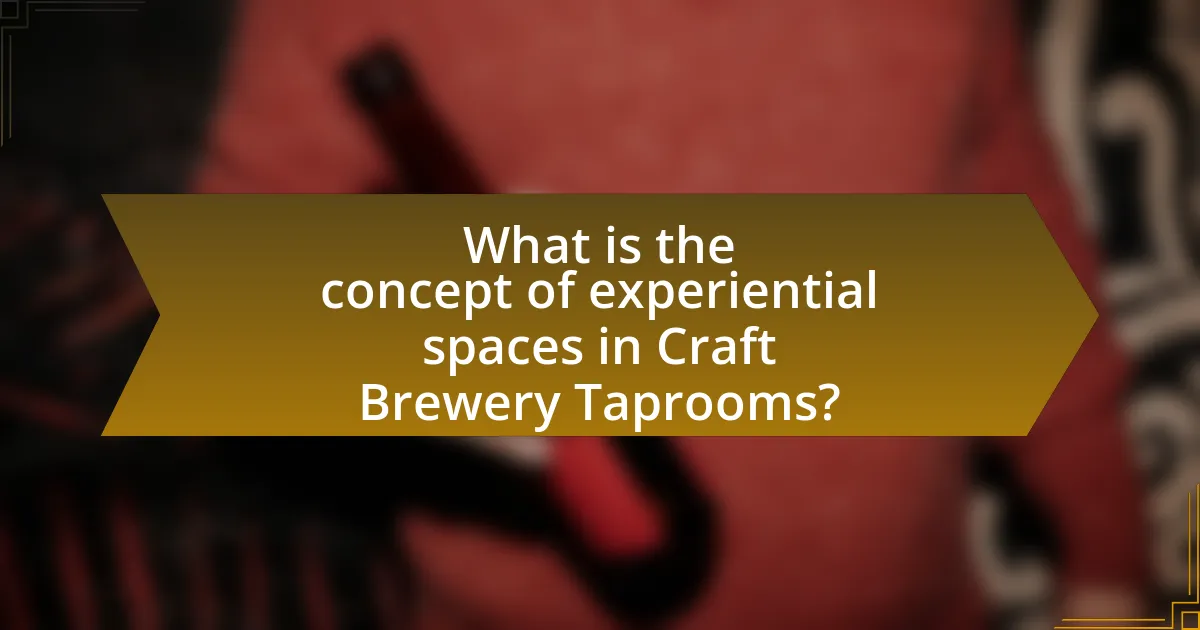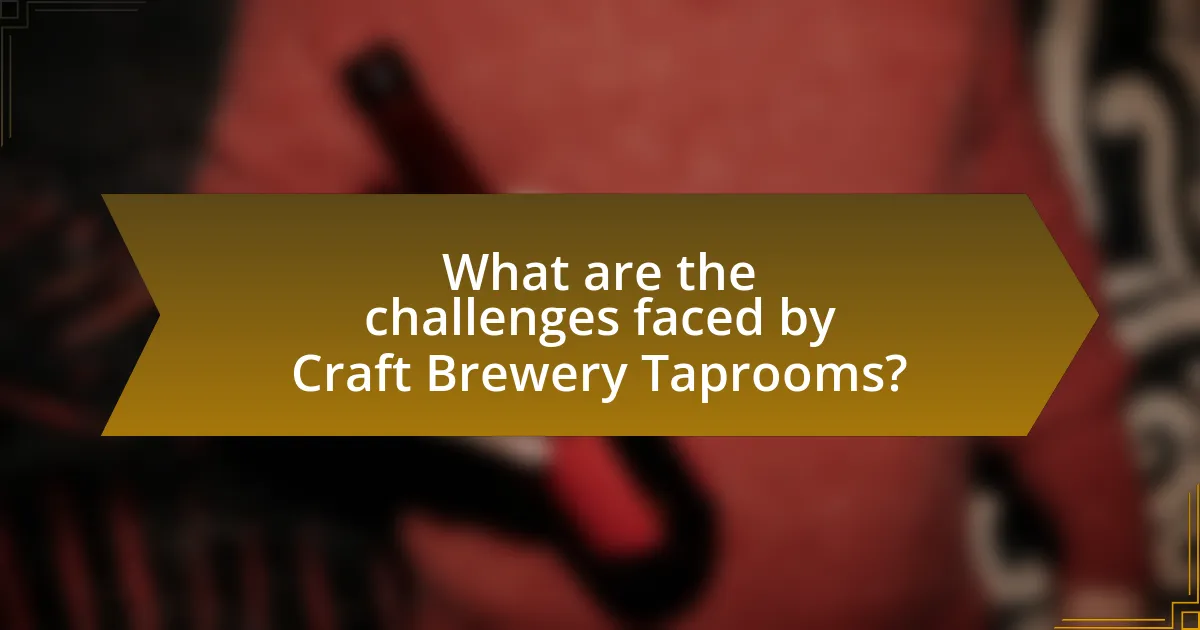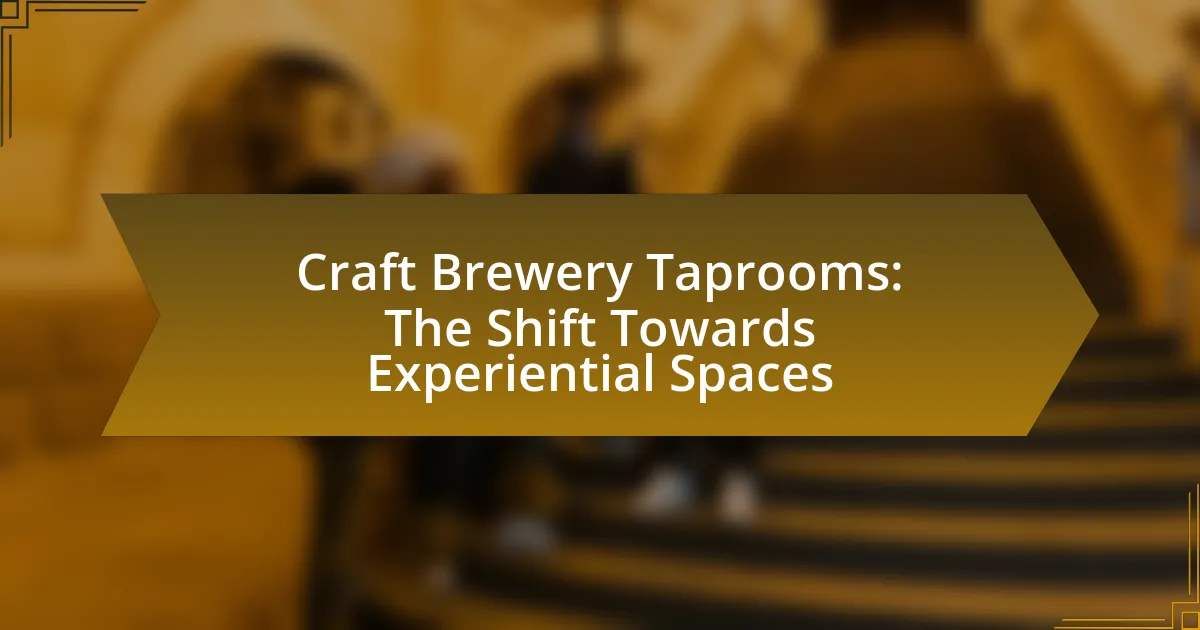Craft brewery taprooms are specialized spaces within breweries that allow customers to sample and purchase beers directly from the source, fostering a community atmosphere and enhancing customer engagement. This article explores the unique features of craft brewery taprooms, including their focus on experiential spaces, customer interaction, and community involvement, which differentiate them from traditional breweries. It also examines the trends driving their popularity, the importance of ambiance and local partnerships, and the challenges faced by taprooms in a competitive market. Additionally, best practices for creating successful taprooms and strategies for effective marketing and customer feedback are discussed, highlighting the significance of providing memorable experiences to enhance customer loyalty.

What are Craft Brewery Taprooms?
Craft brewery taprooms are dedicated spaces within breweries where customers can sample and purchase the brewery’s beers directly. These taprooms often feature a variety of the brewery’s offerings, allowing patrons to experience the full range of flavors and styles produced on-site. According to the Brewers Association, taprooms have become increasingly popular as they provide a direct connection between consumers and the brewing process, fostering a community atmosphere and enhancing customer engagement with the brand.
How do Craft Brewery Taprooms differ from traditional breweries?
Craft brewery taprooms differ from traditional breweries primarily in their focus on customer experience and direct engagement with patrons. While traditional breweries often emphasize production and distribution, craft brewery taprooms create an inviting atmosphere where customers can taste a variety of beers on-site, fostering a community-oriented environment. This shift towards experiential spaces is supported by the fact that many craft breweries prioritize small-batch brewing and unique flavors, allowing patrons to enjoy exclusive offerings that are not widely available. Additionally, taprooms often host events, food pairings, and live music, enhancing the social experience and differentiating them from the more industrial feel of traditional breweries.
What unique features define a Craft Brewery Taproom?
A Craft Brewery Taproom is defined by its focus on providing a direct connection between the brewery and its customers, often featuring a unique atmosphere that emphasizes the brewing process. These taprooms typically showcase a rotating selection of house-made beers, allowing patrons to sample a variety of styles and flavors directly from the source. Additionally, many taprooms incorporate elements such as open brewing areas, community seating, and local art, fostering a sense of community and engagement. The emphasis on experiential offerings, such as brewery tours and tastings, further enhances the customer experience, making it distinct from traditional bars or restaurants.
How do taproom layouts enhance customer experience?
Taproom layouts enhance customer experience by creating inviting and functional spaces that encourage social interaction and engagement. Well-designed layouts often include open seating arrangements, communal tables, and designated areas for activities, which foster a sense of community among patrons. Research indicates that environments promoting socialization can increase customer satisfaction and retention; for instance, a study published in the Journal of Hospitality and Tourism Research found that spatial configurations significantly impact customer perceptions of comfort and enjoyment. Additionally, incorporating elements like visual aesthetics, ambient lighting, and interactive features can further elevate the overall experience, making customers more likely to return and recommend the taproom to others.
Why are Craft Brewery Taprooms gaining popularity?
Craft Brewery Taprooms are gaining popularity due to their unique ability to offer immersive experiences that connect consumers directly with the brewing process. This trend is supported by a growing consumer preference for local, artisanal products, as evidenced by a 2022 survey indicating that 70% of craft beer drinkers prioritize local breweries. Additionally, taprooms often provide a social atmosphere that fosters community engagement, with many hosting events and tastings that enhance customer loyalty. The combination of quality, locality, and community interaction makes craft brewery taprooms increasingly appealing to consumers.
What trends are driving the shift towards experiential spaces?
The shift towards experiential spaces is primarily driven by consumer demand for immersive and engaging experiences. This trend is evident as consumers increasingly prioritize experiences over material goods, with studies indicating that 78% of millennials prefer spending on experiences rather than possessions. Additionally, the rise of social media has amplified the desire for unique, shareable moments, prompting businesses, including craft breweries, to create environments that foster interaction and community engagement. This focus on experiential offerings not only enhances customer satisfaction but also encourages brand loyalty, as patrons are more likely to return to spaces that provide memorable experiences.
How do consumer preferences influence taproom designs?
Consumer preferences significantly influence taproom designs by prioritizing experiential elements that enhance customer engagement. Modern consumers favor social spaces that encourage interaction, leading breweries to incorporate open layouts, communal seating, and versatile areas for events. Research indicates that 70% of consumers prefer venues that offer unique experiences, prompting taprooms to integrate local art, craft food pairings, and immersive brewing experiences. This alignment with consumer desires not only attracts patrons but also fosters brand loyalty, as evidenced by a 2019 survey showing that 65% of customers return to establishments that provide memorable experiences.

What is the concept of experiential spaces in Craft Brewery Taprooms?
The concept of experiential spaces in craft brewery taprooms refers to environments designed to enhance customer engagement through immersive experiences. These spaces prioritize interaction, sensory stimulation, and community involvement, allowing patrons to connect with the brewery’s brand and products on a deeper level. For instance, many taprooms incorporate elements such as guided tastings, brewery tours, and events that foster social connections, which have been shown to increase customer loyalty and satisfaction. Research indicates that experiential marketing strategies can lead to a 20% increase in customer retention rates, highlighting the effectiveness of these experiential spaces in creating memorable customer experiences.
How do experiential spaces enhance the brewery experience?
Experiential spaces enhance the brewery experience by creating immersive environments that engage customers on multiple sensory levels. These spaces often include interactive elements such as guided tastings, brewery tours, and unique design features that reflect the brand’s identity. Research indicates that 70% of consumers prefer experiences over products, highlighting the importance of creating memorable interactions in breweries. By fostering social connections and providing educational opportunities, experiential spaces not only increase customer satisfaction but also encourage repeat visits, ultimately driving sales and brand loyalty.
What activities and events are commonly hosted in taprooms?
Taprooms commonly host activities and events such as beer tastings, live music performances, trivia nights, and food pairings. These events enhance customer engagement and create a social atmosphere, which is essential for the experiential focus of craft brewery taprooms. For instance, beer tastings allow patrons to sample various brews, while live music can attract larger crowds, contributing to increased sales and community involvement. Trivia nights often encourage repeat visits, fostering a loyal customer base. According to a survey by the Brewers Association, 70% of craft breweries reported hosting events to enhance customer experience, demonstrating the significance of these activities in taproom operations.
How does ambiance contribute to the overall experience?
Ambiance significantly enhances the overall experience by creating an emotional and sensory environment that influences customer perceptions and behaviors. In craft brewery taprooms, elements such as lighting, music, decor, and layout work together to evoke feelings of comfort, excitement, or relaxation, which can lead to longer visits and increased spending. Research indicates that 70% of consumer decisions are influenced by the ambiance of a space, highlighting its critical role in shaping customer satisfaction and loyalty.
Why is community engagement important in Craft Brewery Taprooms?
Community engagement is crucial in craft brewery taprooms because it fosters a sense of belonging and loyalty among customers. Engaged communities often lead to increased patronage, as individuals feel more connected to a brand that values their input and participation. According to a study by the Brewers Association, breweries that actively engage with their local communities see a 20% increase in customer retention rates. This connection not only enhances the customer experience but also encourages word-of-mouth marketing, which is vital for the growth of craft breweries.
How do taprooms foster a sense of community among patrons?
Taprooms foster a sense of community among patrons by creating inviting social environments that encourage interaction and shared experiences. These spaces often feature communal seating, events like trivia nights or live music, and opportunities for patrons to engage with local brewers, which enhances social connections. Research indicates that 70% of patrons visit taprooms for the social atmosphere, highlighting their role as community hubs where individuals can meet, share stories, and build relationships over craft beer.
What role do local partnerships play in taproom success?
Local partnerships are crucial for taproom success as they enhance community engagement and drive customer loyalty. Collaborating with local businesses, such as farms for fresh ingredients or nearby restaurants for food pairings, creates a unique experience that attracts customers. For instance, a study by the Brewers Association highlights that breweries with strong local ties see a 20% increase in foot traffic compared to those without such partnerships. This connection fosters a sense of belonging and encourages repeat visits, ultimately contributing to the taproom’s profitability and sustainability.

What are the challenges faced by Craft Brewery Taprooms?
Craft brewery taprooms face several challenges, including competition, regulatory hurdles, and operational costs. The craft beer market is saturated, with over 8,000 breweries in the U.S. as of 2023, making it difficult for individual taprooms to stand out. Additionally, taprooms must navigate complex local and state regulations regarding alcohol sales, which can vary significantly and impact operational flexibility. High operational costs, including rent, staffing, and ingredient sourcing, further strain profitability, especially for new entrants in the market. These factors collectively hinder the growth and sustainability of craft brewery taprooms.
How do operational costs impact taproom sustainability?
Operational costs significantly impact taproom sustainability by influencing profitability and resource allocation. High operational costs, such as rent, utilities, and labor, can strain financial resources, making it challenging for taprooms to invest in sustainable practices like sourcing local ingredients or implementing energy-efficient systems. For instance, a study by the Brewers Association indicates that breweries with lower operational costs can allocate more funds toward sustainable initiatives, enhancing their overall environmental impact and community engagement. Thus, managing operational costs effectively is crucial for taprooms aiming to maintain sustainability while providing quality experiences.
What strategies can taprooms implement to manage costs effectively?
Taprooms can manage costs effectively by implementing strategies such as optimizing inventory management, reducing waste, and leveraging technology for operational efficiency. Optimizing inventory management involves tracking sales trends to ensure that popular items are well-stocked while minimizing overstock of less popular products, which can lead to spoilage and increased costs. Reducing waste can be achieved through practices like repurposing spent grains for food items or donating unsold products, which not only cuts costs but also enhances community engagement. Leveraging technology, such as point-of-sale systems that provide real-time data analytics, allows taprooms to make informed decisions about staffing, pricing, and promotions, ultimately leading to cost savings and improved profitability.
How can taprooms adapt to changing regulations and market conditions?
Taprooms can adapt to changing regulations and market conditions by implementing flexible operational strategies and diversifying their offerings. For instance, many taprooms have started to embrace outdoor seating and takeout options in response to health regulations, which allows them to maintain customer engagement while complying with safety guidelines. Additionally, taprooms can introduce seasonal or limited-edition brews to attract customers and respond to market trends, as seen in the rise of craft beer popularity, which increased by 4% in sales volume in 2020 according to the Brewers Association. By staying informed about regulatory changes and consumer preferences, taprooms can pivot their business models effectively, ensuring sustainability and growth in a dynamic market.
What are best practices for creating a successful Craft Brewery Taproom?
To create a successful craft brewery taproom, focus on providing a unique and engaging customer experience. This includes designing an inviting atmosphere that reflects the brewery’s brand, offering a diverse selection of high-quality beers, and incorporating interactive elements such as brewery tours or tastings. Research indicates that taprooms with a strong sense of community and events, such as live music or food pairings, attract more visitors and enhance customer loyalty. For instance, a study by the Brewers Association found that breweries with taprooms that host regular events see a 30% increase in customer retention.
How can taprooms effectively market their unique offerings?
Taprooms can effectively market their unique offerings by leveraging experiential marketing strategies that engage customers directly. This includes hosting events such as beer tastings, food pairings, and live music, which create memorable experiences that highlight their distinct brews. According to a study by the Brewers Association, 70% of craft beer consumers are influenced by events and experiences when choosing where to drink. Additionally, taprooms can utilize social media platforms to showcase their unique offerings through visually appealing content, customer testimonials, and behind-the-scenes looks at the brewing process, further enhancing customer engagement and brand loyalty.
What customer feedback mechanisms can improve taproom experiences?
Customer feedback mechanisms that can improve taproom experiences include surveys, comment cards, and digital feedback platforms. Surveys, often conducted post-visit, allow customers to share their opinions on various aspects such as service quality and product selection, providing actionable insights for taproom management. Comment cards placed at tables enable immediate feedback during the visit, fostering a responsive environment. Digital feedback platforms, such as mobile apps or social media, facilitate real-time engagement and allow for broader reach, capturing diverse customer perspectives. Research indicates that establishments utilizing these mechanisms can see a 20% increase in customer satisfaction ratings, demonstrating their effectiveness in enhancing the overall taproom experience.
What tips can enhance the Craft Brewery Taproom experience for visitors?
To enhance the Craft Brewery Taproom experience for visitors, breweries should focus on creating an inviting atmosphere, offering diverse beer selections, and providing engaging activities. An inviting atmosphere can be achieved through comfortable seating, ambient lighting, and friendly staff, which encourages social interaction and relaxation. A diverse beer selection, including seasonal and limited-edition brews, caters to various tastes and enhances the tasting experience. Engaging activities such as brewery tours, beer tastings, and live music events foster a sense of community and make visits memorable. According to a study by the Brewers Association, taprooms that prioritize customer experience see a 20% increase in repeat visits, demonstrating the effectiveness of these strategies.
